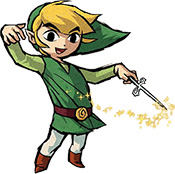The Wind Waker
Release Date
GameCube
US : March 24, 2003
Japan : December 13, 2002
Europe : May 3, 2003
Wii U (WW HD)
US : September 20, 2013
Japan : September 26, 2013
Europe : October 4, 2013
Developer
Publisher : Nintendo
Developer : Nintendo
Director : Eiji Aonuma
Producer : Shigeru Miyamoto
Game
Genre : Action, Adventure
Platform : GameCube
Game Type : 5cm Disc
Mode : Single and Multiplayer
Memory : 12 card blocks
Other : Game Boy Advance connections
Ratings
ESRB : E (Everyone)
ELSPA : 3+
PEGI : 7+
OFLC : G8+
Reviews
Metacritic : 96%, 90% (HD)
 On the small island of Outset in the corner of a vast ocean is a tiny village. In that village live Link, his sister Aryll, their grandmother, and a few other inhabitants. Outset is a peaceful place to live, nothing major ever happens. On the twelfth birthday of Link, a supposedly regular day, a mysterious bird swoops over the island with a pirate boat in hot pursuit. In the talons of the winged creature is a girl, taken from that very pirate ship. The girl, Tetra, was the captain of that ship. The pirates, upset over the kidnapping of their leader, are intent at stopping the bird at all costs.
On the small island of Outset in the corner of a vast ocean is a tiny village. In that village live Link, his sister Aryll, their grandmother, and a few other inhabitants. Outset is a peaceful place to live, nothing major ever happens. On the twelfth birthday of Link, a supposedly regular day, a mysterious bird swoops over the island with a pirate boat in hot pursuit. In the talons of the winged creature is a girl, taken from that very pirate ship. The girl, Tetra, was the captain of that ship. The pirates, upset over the kidnapping of their leader, are intent at stopping the bird at all costs.
Of course, Link heads off to rescue the damsel in distress. Once Link has finished saving the kidnapped pirate, Aryll is taken hostage by the fowl who takes her to another mighty island. Link, intent on saving his sister, pleads for the pirates to take him to the island where the bird has roosted. After much discussion and an intervention by the local Rito postman, Quill, Tetra and her crew cave in and take Link on their boat. From there, the aspiring hero takes on a quest of immense proportions that take him to all corner of the Great Sea.
The Legend of Zelda: The Wind Waker is the tenth installment in The Legend of Zelda series of video games. It was released for the Nintendo GameCube in Japan on 13 December 2002, in Canada and the United States on 24 March 2003, in Europe on 3 May 2003 and in Australia on 7 May 2003. The Legend of Zelda: Phantom Hourglass for the Nintendo DS is the direct sequel to The Wind Waker.
The game is set on a group of islands in a vast sea—a first for the series. The player controls Link, the protagonist of the Zelda series. He struggles against his nemesis, Ganondorf, for control of a sacred relic known as the Triforce. Link spends a significant portion of the game sailing, traveling between islands, and traversing through dungeons and temples to gain the power necessary to defeat Ganondorf. He also spends time trying to find his little sister.
The Wind Waker follows in the footsteps of Ocarina of Time, retaining the basic gameplay and control system from the Nintendo 64 title. A heavy emphasis is placed on using and controlling wind with a baton called the Wind Waker, which aids sailing and floating in air. Critics enjoyed the similarity to Ocarina of Time, but often complained that the large amount of sailing became tedious. Despite this, the game has met commercial and critical success and is the fourth of only six games that have received a perfect score from Famitsu magazine.
The Wind Waker is also notable for being at the time controversal to many gamers. Going from the realistic art style of the previous 3D Zelda titles as well as the GameCube Zelda tech demo shown off at Spaceworld 2000, to the cartoonish, cel-shading of what became The Wind Waker proved very divisive among gamers and the Zelda fanbase which ultimately led to lower sales of the title outside of Japan.

